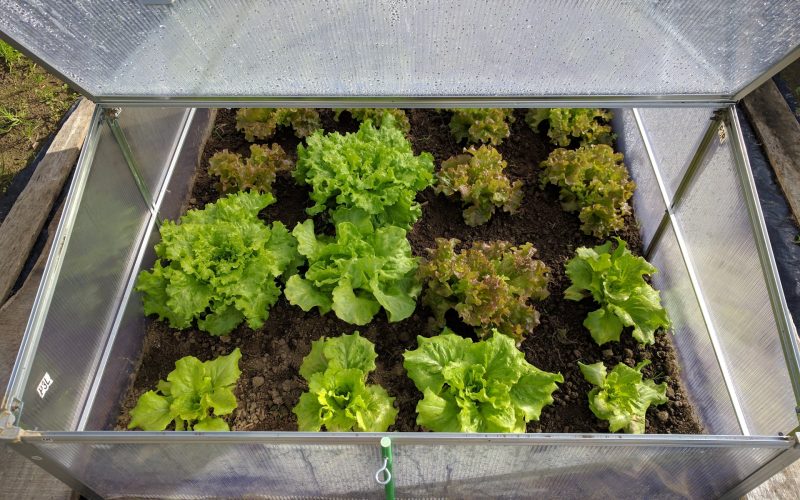Before finding out what are good things to grow in a small greenhouse, it is essential to discuss what the mini greenhouse is. The greenhouse is such an excellent structure to have in your area because of what they can do for your plantation.
The greenhouse pertains to the structure that is featured with roofing and walls made from an excellent transparent material, which includes glass where plants can thrive under ideal climate conditions. The structures range from tiny sheds to buildings of industrial sizes. The mini greenhouse is also known to be the cold frame.

Having your greenhouse offers several benefits. No matter what your gardening style is, the greenhouse is known to enhance the efficiency of planting, as well as the outcome. The advantages can include climate management, protection of plants, and giving the crops their more extended growing season, plus so much more it can offer.
What Can You Grow In A Small Greenhouse?
Take note that the focal point of the discussion right here is growing in the mini greenhouse. The size is tinier compared to the traditional form of the greenhouse. So what are the crops that are best to grow in the small greenhouse?
Spring
As the spring comes, the mini greenhouse can be filled with various young plantations, right from the beginning of the season. They may include crops that are cultivated directly from the seed, including your fresh salads.
Summer
In the summer season, the small greenhouse can be a place where you can grow protected crops such as aubergines, cucumbers, peppers, and tomatoes. You can also use the structure to have your home-grown crops of the Mediterranean variant.
Fall
During the fall season, remember that the popular crops are florals such as geraniums and fuchsias, plus vegetables such as salad greens and lettuce. You can also plant spring cabbage in the fall season toward the winter months.
Winter
As the world goes toward winter, change up the growing pattern and have fuchsias, geraniums, and other delicate plantations. You can also have bulbs for the mini-greenhouse.
Growing Aubergines In A Greenhouse
Though the aubergine can be grown outdoors, they also do great in the mini-greenhouse. They are cultivated in a three-and-a-half-inch pot at first, and once the pot is already filled with the roots, the gardener must be able to transport the plant to a nine-inch pot of compost in April when the farmer is in the heated structure or greenhouse. Then, this must go early May or June when grown outdoors.
The aubergines may also be cultivated right on the open ground in the warmer areas of Europe, spacing at two feet apart and covered with fleece in the ideal setup. The key to succeeding here is providing sufficient warmth and sunshine to uplift the growing scenes.
You may also utilize polythene to warm the soil about two weeks before planting once the frost danger and young plantation covering have already acclimatized. You may have them in sunny areas against sheltered walls. Be sure to stake, water, and remove the rest of the flowers.
How To Grow Cucumbers In A Greenhouse
Meanwhile, among the most thrilling crops to grow is the cucumber too. The star of the spring season, but since you have the greenhouse, you can have them in almost all parts of the year.
What you can do is to begin sowing the seeds of the cucumber in the final three weeks before the date of the frost so you can be able to transplant them a week before the frost wanes. This is necessary since the crop tends to get most vulnerable from damage due to frost.
Heaters of your greenhouse can help you achieve the needed warmth for the cucumbers in the freezing periods. In this way, you will never have to consider frost dates, and you can cultivate them throughout the entire year.
When you cultivate cucumbers in pots, they also present magnanimous opportunities. What’s recommended is, sowing a seed for each of your three-inch pots. This provides you with enough place to grow the plant initially.
Ensure you can sow the crop in the so-called peat pots or those constructed with peat so you can have them transplanted without extraction since the root systems won’t get disturbed. Three weeks after beginning the seeds, prepare your patch within the structure where the seedlings get transplanted.
Growing Peppers in Your Greenhouse
First, start sowing your seeds in about eight weeks before transplanting. Maintain the temperature of the soil at 32 degrees Celsius. Once the first leaves show up, transport the seedlings to the containers.
Secondly, grow the plants to about 21 to 23 degrees Celsius, and fertilize. In the transplantation with the greenhouse, the temperature during the day must be at 24 degrees Celsius while at 22 degrees Celsius at night, especially in the week after this phase. This allows fast growth of the vegetation and promotion of good root support.
What are good things to grow in a small greenhouse? Well, they may say growing in the greenhouse depends on the season, but this is the precise benefit of the greenhouse — to allow you to grow just any crop any time of the year.
